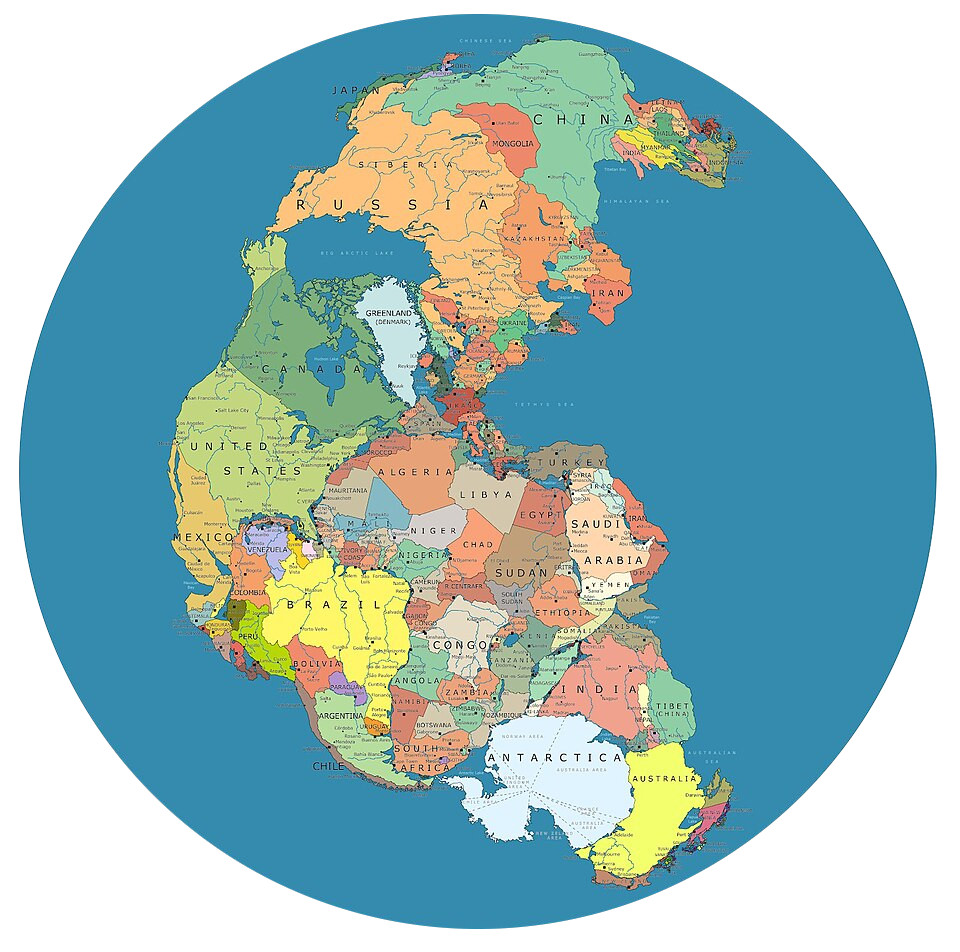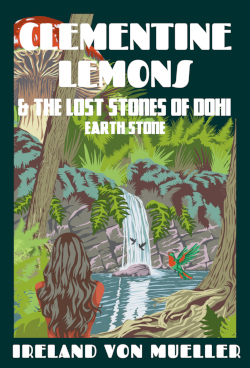The Supercontinent of PangAea
When Clementine first arrives in Pangier, she has no idea where she is or how she got there. It isn’t until she meets Kiwi and Emos and sees a map that she realizes she is in a dimension where the supercontinent of Panagea never broke apart.
But what exactly was Pangaea?
WHAT WAS PANGAEA?
In short, Pangaea (also spelled Pangea), was a supercontinent—a massive landmass that included all seven of today’s continents!
During Pangaea’s existence, almost all of Earth’s landmasses were clumped together into one enormous landform surrounded by a global ocean called Panthalassa (Ghose & Gegge, LiveScience, 2024). This means that, had we been alive then, we could have walked from what is now North America all the way to Africa without ever crossing an ocean!
Throughout our planet’s 4.5+ billion-year history, many supercontinents have formed and broken apart, including Pannotia, Gondwana, and Pangaea (Ralls, Earth.com, n.d.) Pangaea was the most recent of these supercontinents, forming around 335 million years ago, during the Carboniferous Period, and breaking apart around 175 million years ago, during the Late Triasic/Early Jurassic Period (Ralls, Earth.com, n.d.).
How do scientists know Pangaea was real?! Fossils of the same plant and animal species, such as the reptile Mesosaurus and the fern Glossopteris, have been found on continents now separated by oceans — suggesting these landmasses were once joined (USGS, 2012). Geologists have also discovered that the mountain ranges and rock layers in North America, Europe, and Africa match almost perfectly, as if they had been torn apart (National Park Service, n.d.). And perhaps the coolest clue: our modern continents still fit together like pieces of a giant jigsaw puzzle (See the map below!).
Video: What Did Pangaea Look Like?, via YouTube (AtlasPro, 2019)
WHAT DID PANGAEA LOOK LIKE?
From space, Pangaea resembled a giant “C” shape, stretching from pole to pole (Britannica, n.d.). The Panthalassa Ocean—or, as they call it in Pangier, the Pantha—surrounded this enormous landmass (Britannica, n.d.). On the eastern coast, in the curve of the “C”, was a water body known as the Tethys Sea (Britannica, n.d.).
Where present-day North America met Africa and Europe, sat the Central Pangean Mountains. At their historical highest, this range would have rivaled the Himalayas (Wikipedia, n.d.). Due to their sheer size, they likely acted as a formidable barrier, creating a rain shadow and arid deserts to the north (Wikipedia, n.d.). On the southern side of the mountains, persistent rainfall would have created lush, tropical, and swampy land (Ghose & Gegge, LiveScience, 2024).
Along the coast of Pangaea, seasonal megamonsoons would have generated significant moisture and precipitation. This moisture, combined with hot temperatures, created perfect conditions for plant growth. Towering trees and massive fern species, such as Glossopteris (reaching heights of 30 meters!), would have dominated the landscape.
The interior of this vast supercontinent was likely cooler and more arid (Britannica, n.d.).
Throughout time, Pangaea’s was home to a huge array of animal species ranging from the first mammals to the first dinosaurs. In the tropics and wetlands, amphibians and the first reptiles would have lurked in the forest, rivers, and swamps (Davis, National History Museum, n.d.). During the Triassic, and the last 60-70 million years of Pangaea’s existence, dinosaurs emerged and eventually dominated the landscape (Davis, National History Museum, n.d.). The Panthalasa teemed with life. On the ground, the first mammals appeared. And in the skies, the first winged creatures (Pterosaurs) took flight.
WHAT HAPPENED TO PANGAEA?
Plate tectonics! According to the USGS, the theory of plate tectonics posits that the Earth’s outermost layer is fragmented into plates, which move as they ride atop the hotter, more mobile material beneath (Kious & Tilling, USGS, 1996).
Roughly 235 million years ago, during the late Triassic period, Pangaea began to break apart, driven by the motion of Earth’s tectonic plates — a process known as rifting (Issitt, EBSCO, 2024). Initially, the supercontinent split into two large landmasses: Laurasia in the north and Gondwana in the south (Issitt, EBSCO, 2024). Fast-forward to approximately 130 to 150 million years ago, Gondwana broke further apart, resulting in the formation of the continents of Australia, India, South America, and Africa (Issitt, EBSCO, 2024). Then, 65 million years ago, Laurasia split, forming the continents of North America, Europe, and Asia (Issitt, EBSCO, 2024). As the much smaller continents drifted apart, the oceans, including the Atlantic, Pacific, and Indian, began to open. The map as we know it is only 65 million years old!
Crazier still, researchers believe the continents may one day drift back together (250-ish million years from now!), forming a supercontinent they call Pangaea Ultima (Issitt, EBSCO, 2024)!
Video: Continental Drift from Pangaea to Today, via YouTube (ArcGIS, 2020)
LIFE AFTER PANGAEA.
When Pangaea broke apart, the world’s biodiversity exploded. Entire populations of plants and animals were suddenly geographically split, evolving into entirely new species through allopatric speciation (Ghose & Gegge, LiveScience, 2024) and dispersal (McIntyre et al., 2017). Smaller, isolated landmasses sparked rapid adaptive radiation, with species adapting to fill new ecological niches (Lovette, Cornell Lab, 2018). Shifting ocean currents created cooler, drier climates—changes that may have boosted speciation and reduced extinction (Jordan et al., 2016). But what if Pangaea hadn’t broken apart? What would its biodiversity look like?
WHAT IF PANGAEA STILL EXISTED?
According to scientists, biodiversity on an “unbroken” Pangaea would be far lower, since many of the drivers of biodiversity wouldn’t have occurred (Hadhazy, LiveScience, 2011). The supercontinent’s interior would also be uncomfortably arid and hot, as precipitation from the ocean would dissipate before reaching that far inland (Hadhazy, LiveScience, 2011). The ‘What If’ video presents another interesting perspective on this scenario—imagining what Pangaea might be like if humans existed, in our present form.
Pangier is my own exploration of this question: What if Pangaea had never broken apart? While Pangier is entirely fictional, I tried to ground some of it in real science and geography. Features like the Central Pangian Range, Mutina’kol’e Swamp, and the Pantha Ocean are inspired by actual geographic features of Pangaea.
Video: What If Pangaea Never Broke Apart?, via YouTube (What If, 2020)
You may also have noticed that Clementine encounters surprisingly little wildlife (and no dinosaurs!), which is due to the limited diversification mentioned above. The plant life, however? Enormous! Skyscraper tall trees, mutant ferns, exotic fruits, and draping flowers abound…likely more variety than existed in ancient Pangaea.
And what about us? Would humans have existed at all? Unlikely, but I like to think so! Maybe we’d have wings, feathers, or gill stalks. After all, who’s to say that in another dimension we don’t look more like birds or amphibians (Amphi!)? And maybe in that world, we barely industrialized at all. Maybe, instead, we learned to live in harmony with nature. And if we did exist…
WHERE WOULD YOU LIVE?
When Clementine realizes Emos’ map shows the supercontinent of Pangaea, her mind is blown, and she immediately tries to remember where the west coast of Canada was located on a similar map she remembered seeing in school.
This map, called Pangaea Political, is artist Massimo Pietrobon’s depiction of how today’s countries and borders might have looked if they existed during the age of Pangaea.
Where would your city or country be located had Pangaea never broken apart? And who would be your neighbors?

Image: Pangaea Political, by Massimo Pietrobon, CC BY 3.0, via Wikimedia Commons.
FUN FACTS!
1. The name Pangaea comes from Ancient Greek and means “All Earth.”
(Ghose & Gegge, LiveScience, 2024)
2. Some scientists think Earth may form another supercontinent in the distant future; they call it “Pangaea Proxima.”
(Issitt, EBSCO, 2024)
3. A mass extinction, known as “The Great Dying,” happened during Pangaea’s existance. It nearly ended life on earth and caused the extiction of 90% of marine species and 70% of land species! Not even trees or microbes were spared!
(NASA, 2002)
4. A man named Alfred Wegener proposed the idea of continental drift in 1912 — and was totally shot down by the scientific community. His initial theory was the precurser to the the theory of plate tectonics. And while he wasn’t right about how how the the continents moved, he certainly was correct that they do! His theory wasn’t perfect, but it became the foundation of modern plate tectonics.
(Kious & Tilling, USGS, 1996)
RESOURCES
LEARN MORE ABOUT PANGAEA!
American Museum of Natural History: The Power of Plate Tectonics
An interactive exploration of how plate tectonics works.
Berkley: Understanding Evolution
A short explanation of how allopatric speciation (geographical isolation) causes evolutionary changes amongst species.
Gizmos: Building Pangaea
An interactive drag-and-drop puzzle designed to help learners fit modern landmasses together to form Pangaea. Fossils, rocks, and glacier layers can be activated to help fit everything together. (Five minutes free; or unlimited use with Gizmo FREE membership.)
HHMI BioInteractive: Earth Viewer
An interactive Globe that allows users to scroll through billions of years (by period) to see how the continents grew, shifted, and drifted. Layers and graphs enable users to explore changes over geologic time in various aspects, including atmospheric composition, climate, biodiversity, etc.
HHMI BioInteractive: Animated Life: Pangaea (Video)
A 7-minute, animated video celebrating Alfred Wegener, the astronomer and atmospheric scientist who first proposed the theory of continental drift.
National Parks Service: Plate Tectonics Lesson Plan
Classroom lesson plan for teaching plate tectonics, and helping students understand plate boundaries (divergent, convergent, and transform). Activities demonstrate how continents fit together and explore the relationship between plate movement, mountain formation, volcanic eruptions, and earthquakes.
Pangaea: Discover facts about Earth’s ancient supercontinent (LiveScience.com)
A comprehensive explanation of Pangaea from its formation to its climate, animals, and ultimate demise. Includes a great video showing how Pangaea Proxima may form.
Supercontinents 101: Pannotia, Gondwana, and Pangea (Earth.com)
An introduction to plate tectonics, the tectonic collisions involved in the formation of supercontinents, and descriptions and timelines of major supercontinent formations.
The Great Dying (NASA)
A great look at what was happening in Pangaea before this mass extinction event, along with an explanation of findings that point to an asteroid impact.
This Dynamic Earth: The Story of Plate Tectonics (USGS.gov)
Written by W. Jacquelyne Kious and Robert I. Tilling, the booklet, “This Dynamic Earth: The Story of Plate Tectonics,” provides an introduction to the theory of plate tectonics, from the individuals and discoveries that advanced the theory to the challenges scientists still face.
